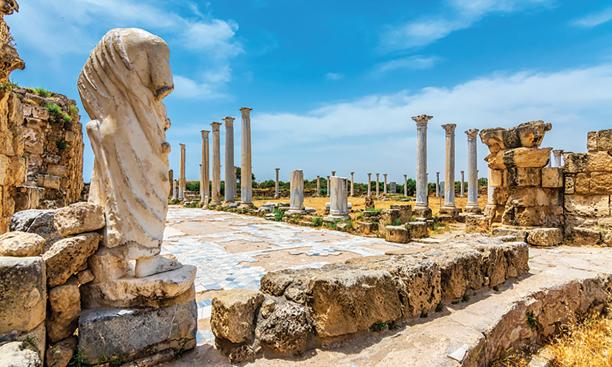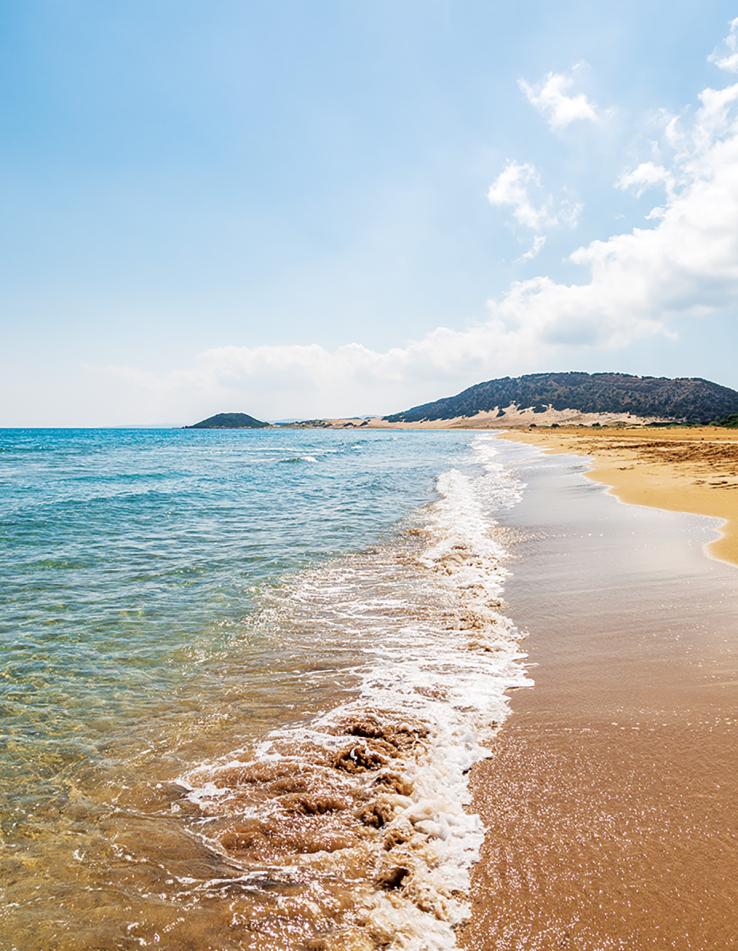
It’s not every day that a feral donkey sticks its head through your car window demanding to be fed, but in Karpaz, the remote easternmost peninsula of the Mediterranean island of Cyprus, the encounter is a regular occurrence.
The donkeys are an artifact of the frozen conflict that partitioned the island, a former British colony, into two communities 50 years ago. Ethnic violence between the Greek Cypriot majority and the Turkish Cypriot minority erupted after the island achieved independence in 1960. In 1974, a Greek coup backed by a dictatorship in Athens deposed the Greek Cypriot president, Archbishop Makarios, with the aim of annexing Cyprus to Greece. Turkey responded with a devastating military invasion and sustained Turkish occupation of the northern part of the island. As Turkish Cypriots fled north and Greek Cypriot farmers retreated to the south, they abandoned their donkeys in the process, allowing the beasts of burden to roam free and accost the unsuspecting motorist.
For half a century, a buffer zone managed by the United Nations has split the island between the southern, Greek Cypriot-dominated Republic of Cyprus (now an EU member) and the northern part, which is officially known internationally as the “Turkish-occupied area.” To Turkish Cypriots, this region is known as the “Turkish Republic of Northern Cyprus,” an unrecognized state whose claim is only endorsed by Turkey. However, 20 years ago, checkpoints opened between the two sides, allowing Cypriots and foreign visitors alike to cross the buffer zone for the first time since 1974.
Meanwhile, the island is only half the size of Connecticut. Its status as a European country and its proximity to Syria and Lebanon have long made Cyprus the meeting place of East and West. And within the two Cypruses are two distinct worlds — the picturesque, isolated region of Karpaz, and the bustling, cosmopolitan city of Limassol.
Northern Cyprus: The Romance of Karpaz
The journey to the wild donkeys begins in the Turkish Cypriot city of Famagusta, the Venetian-fortified port that Shakespeare depicted in Othello, filled with enchanting cathedrals-turned-mosques initially built by French crusaders. Just up the road are the Roman ruins of Salamis, one of the best-preserved ancient sites on the island, where intricate mosaics peek through abandoned archways.
Proceed northeast to the village of Dipkarpaz (literally — “bottom of Karpaz”). Despite the conflict, evidence of the Greek community remains. At the center of the village is the Rum Kahvesi, the Greek coffee house. (Rum, the Turkish word for “Roman,” reflects how the citizens of the Greek-speaking Byzantine Empire referred to themselves for centuries as the inheritors of the Romans.) Take a “Cypriot” coffee here (i.e., Turkish or Greek coffee), before advancing into the untamed Karpaz.

The road here is pitted and worn, the better to dissuade the less committed traveler. One would do well to follow the driver ahead, who probably knows the potholes better. As the strip of farmland narrows between a dual range of low hills, one can catch glimpses of the Mediterranean on either side, revealing how narrow the strip of land has become.
Finally, arrive at Golden Beach, where the fine sand extends along a gorgeous cape and the crystal water shimmers, almost translucent. With hardly any services to speak of, this beach is quiet. It’s easy to lose one’s grip on time in this place, at the border between Europe and the Levant.
After taking a dip and some time to absorb the restorative powers of the ancient sun, continue along the road, past the aggressive donkeys (a sign reads “Beware of the Feral Donkey”), to witness the Apostolos Andreas Monastery. After the war, the Greek Orthodox holy site fell into decline, but a recent renovation effort by a team of art restorers, made up of members of both Turkish Cypriot and Greek Cypriot communities, has brought the historic monastery back to its former glory with support from the U.S. Agency for International Development (USAID) and the U.N. Development Program.
Just beyond, the final destination is Sea Bird, a rustic fish tavern at the edge of the sea. Sample the exquisitely fried bream, homemade fries, and arugula salad. This is the oasis at the edge of the island — the height of romance that remote Cyprus can offer.
Southern Cyprus: Limassol, the City In Between
Remote is not for everyone. Others may want to be in the thick of it. Limassol, the thriving metropolis to the south, in the area controlled by the Greek Cypriot-majority Republic of Cyprus, is absolutely where the action is on the island.
It’s thought that Limassol derives from the Greek word anamesos, referring to the city “in between” the more important ancient settlements of Amathus (a temple to Aphrodite, the island’s patron goddess in antiquity) and Kourion (today, the location of impressive Roman ruins). The name of “in between” befits modern Limassol, a city of 235,000 that in the past decade has erected 24 flashy skyscrapers — with another 29 in progress — making Limassol Cyprus’ answer to Dubai.
Limassol’s dynamism is owed to the multiple waves of migration to the city. From the 1974 conflict, many Greek Cypriots from north Cyprus resettled in Limassol. After the Lebanese Civil War in the 1980s, many people from Lebanon arrived as well. Today, Russian and Ukrainian settelers have followed suit.
Take a stroll on the Molos seafront promenade. With its sculptures, variety of cafés, wide walking paths, and public exercise equipment, it’s one of the best public spaces on the island. Nearby, tour the Limassol Castle, apocryphally the site of the wedding of Richard the Lionheart and his wife Berengaria while on crusade. Take kids in tow to the Paradox Museum, a collection of optical illusions in the recently opened Marina, an upscale waterfront mall. For art enthusiasts, a visit to the PSI Foundation is a must. Located inside a historic building designed to store carob harvests (historically, one of Cyprus’ most important exports), this modernist architectural landmark now serves as the venue for an exhibition spotlighting Cypriot art.
All this development has provoked its share of hand-wringing about what to do about the unabated growth of the city. In June 2024, Limassol answered, electing local architect Yiannis Armeftis mayor on a platform of sustainable urban design, expanded public transit options, and the construction of additional parks. Such reforms will be welcomed, but even so, Limassol — like the rest of Cyprus — will remain a place trapped in geopolitical limbo. Thanks to the unresolved conflict, Cyprus continues to be an island tragically caught “in between.”
Where to stay:
Karpaz
Revakli Ev Guest House, with its charming arched rooms dating back to 1912, offers modest accommodation with a full Turkish breakfast every morning. From $102/night.
Limassol
Located in a quieter neighborhood than the waterfront, four-star Alasia Boutique Hotel & Spa offers a taste of luxury with a spa and restaurant featuring a consultant Michelin Star chef. From $183/night; spa packages start at $240.
What to eat:
Karpaz
Order a refreshing Efesbeer, arugula salad, fries, red snapper, and bream at Sea Bird, the open-air fish tavern perched on a cliff at the end of the Karpaz peninsula.
Limassol
At Alieutikó Katafygio (“Fisher’s Refuge”), try the tahini, kalamari,
and octopus legs — as tender as pasta al dente — alongside ice-cold sips of
zivania, a Cypriot pomace brandy similar to Greek ouzo or Turkish raki.
Getting there:
Larnaca is the main airport of the Republic of Cyprus. (Ercan Airport in the northern part of Cyprus is considered an illegal entry to Cyprus; if you enter northern Cyprus from Ercan, you will be denied entry to the Republic of Cyprus. See the State Department’s page on Cyprus for additional information.)*
*Generally, rental cars are forbidden from crossing from one side of the island to the other. A car must be rented on the side of the island it will be driven on; numerous rental companies offer services on both sides of the island.
Guides we recommend: Greek Cypriot art historian Anna Marangou offers guided bus tours of northern Cyprus, sharing her insider knowledge.
Harrison Blackman ’17 is a Los Angeles-based screenwriter and former Fulbright scholar in Cyprus whose work has appeared in the Los Angeles Review of Books, The Brooklyn Rail, and The Santa Fe New Mexican. Check out his Substack The Usonian for more of his writing on Cyprus.
